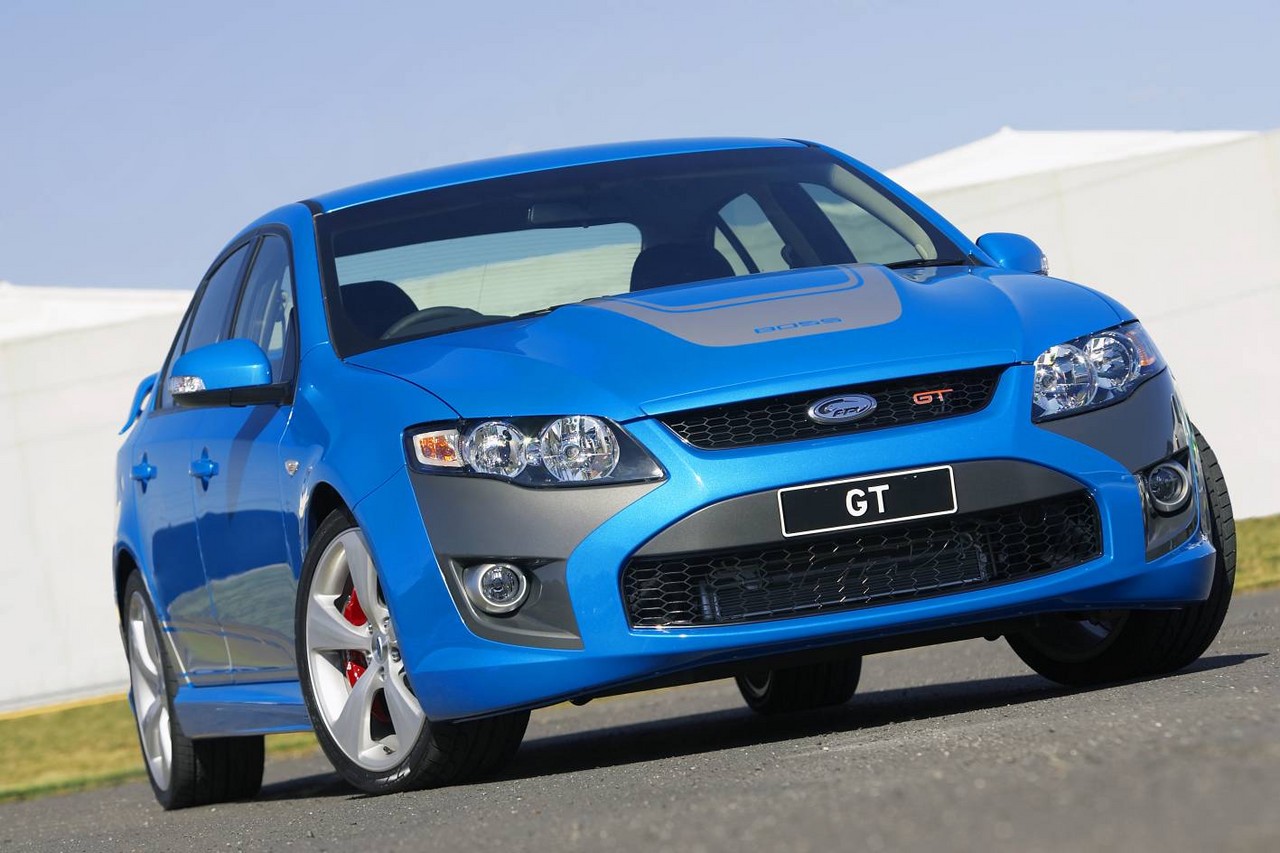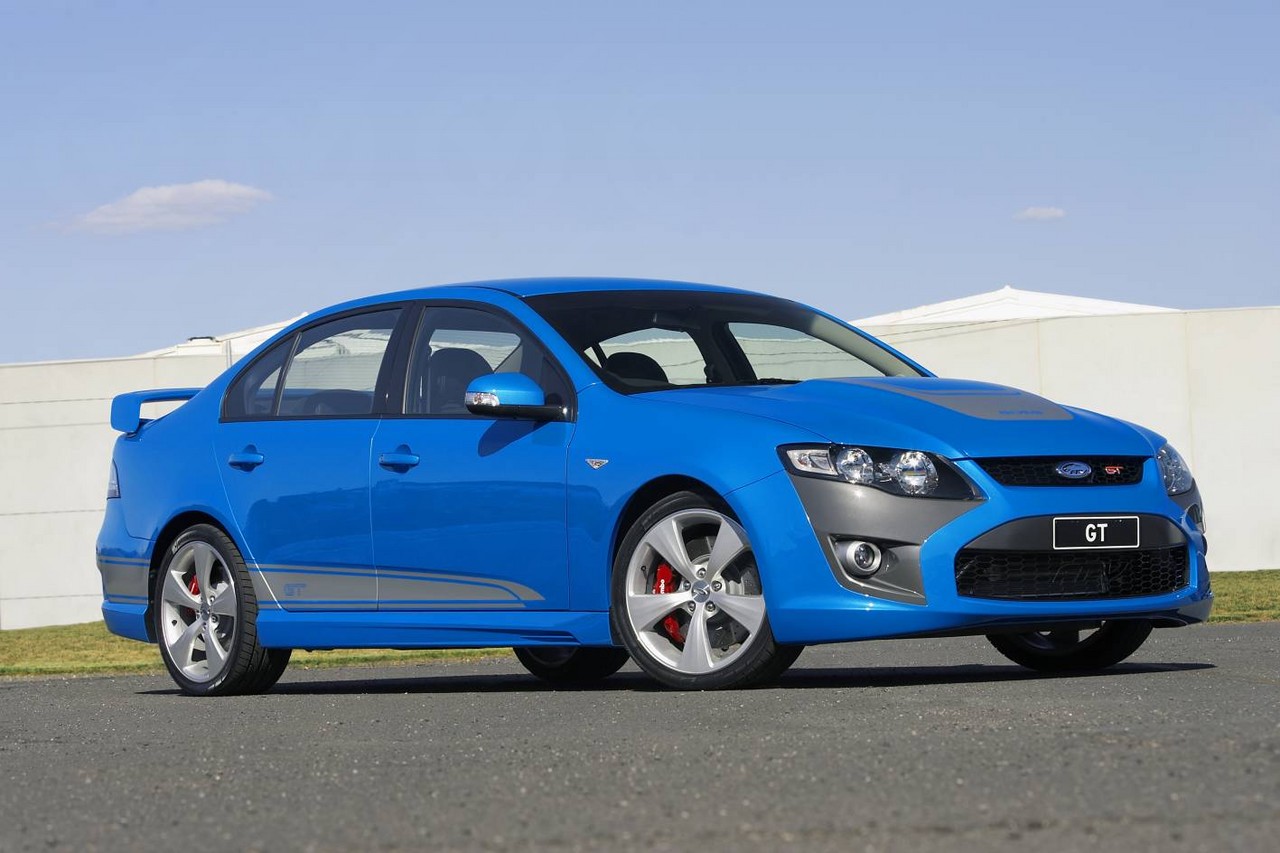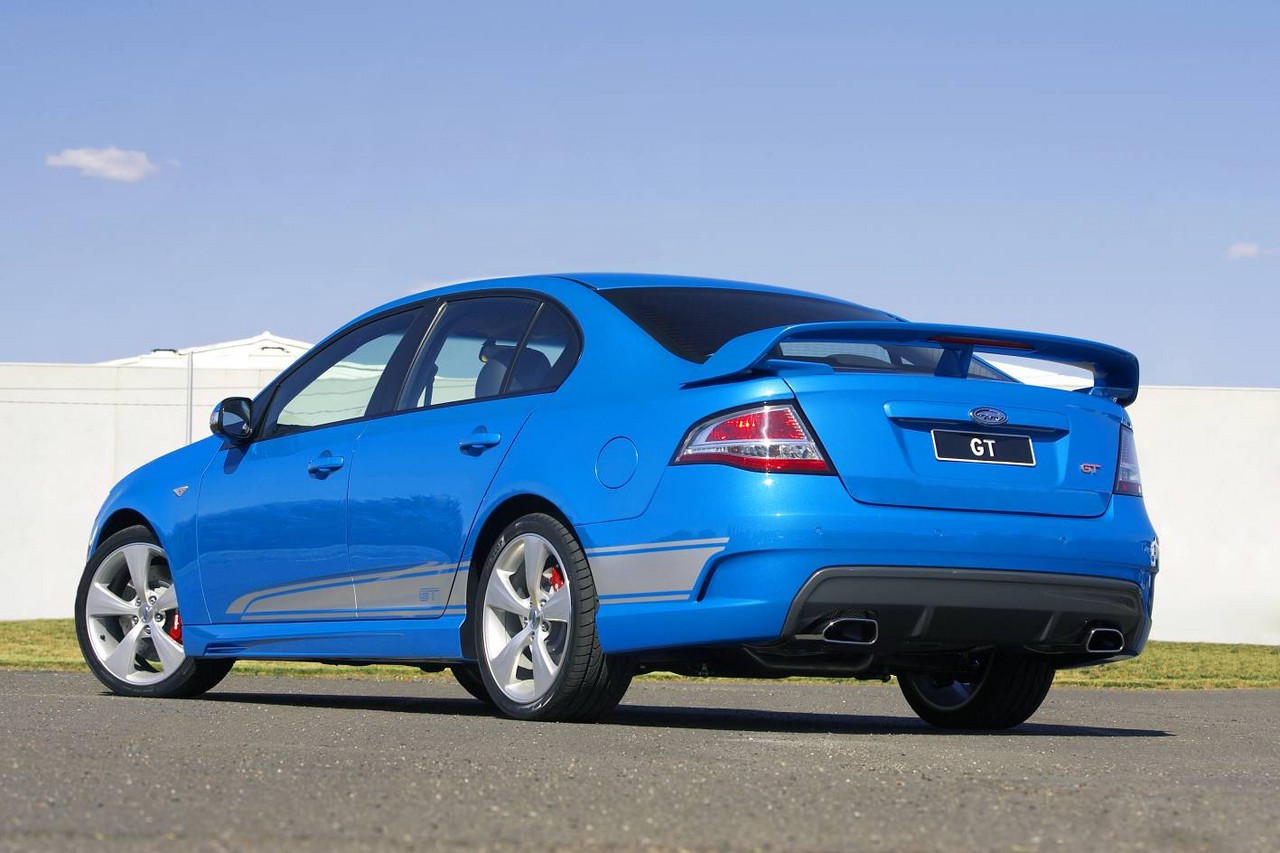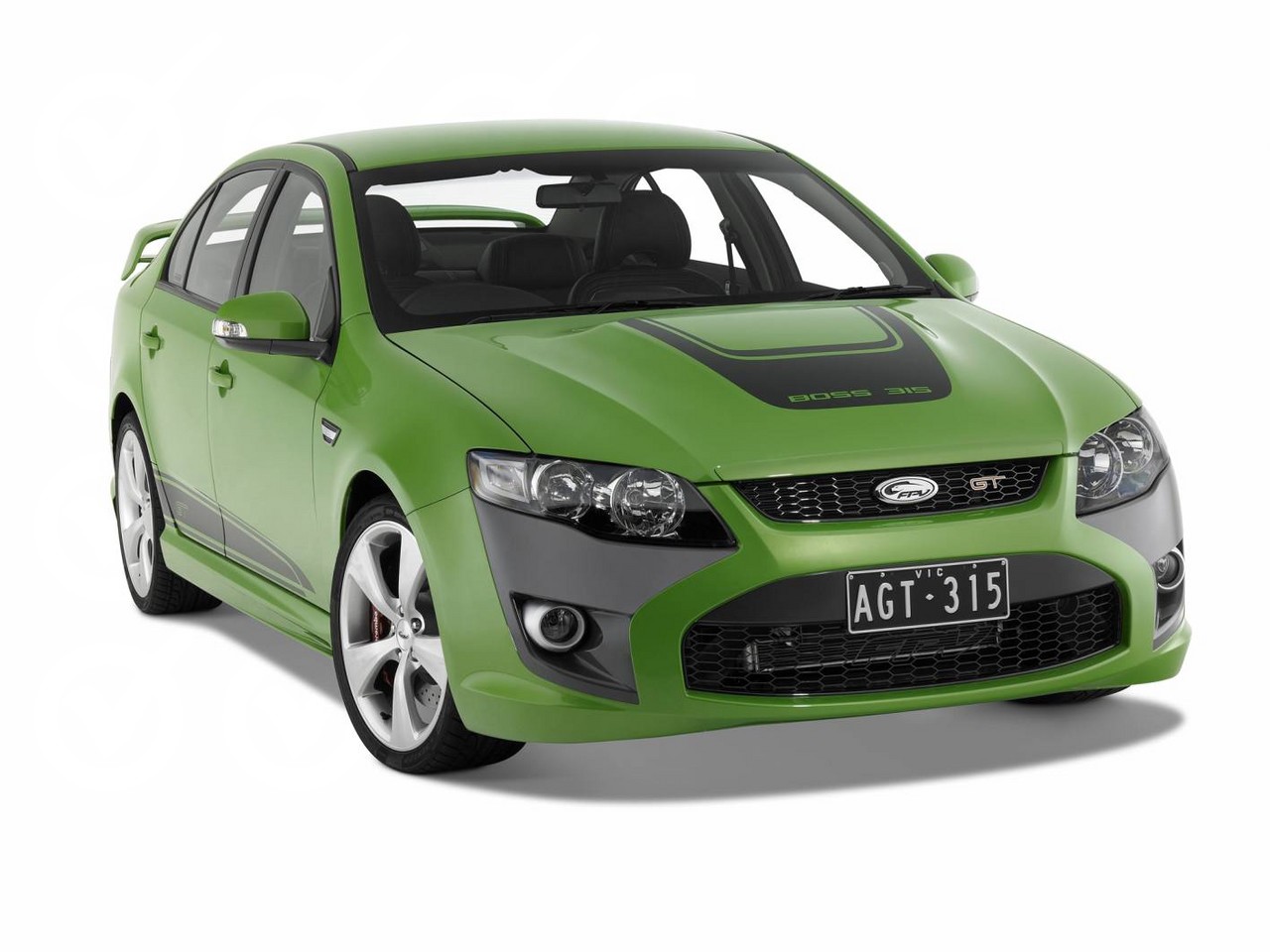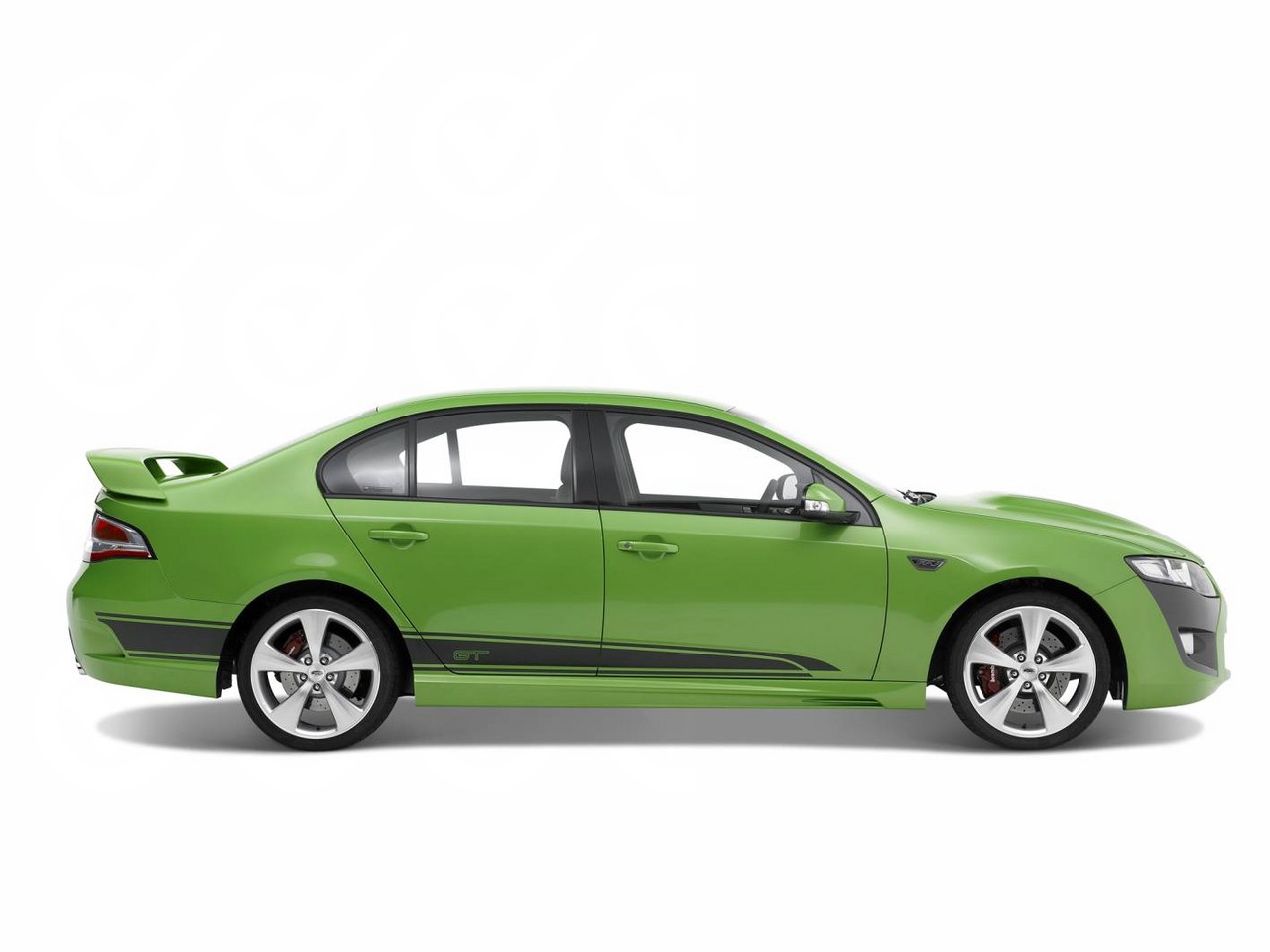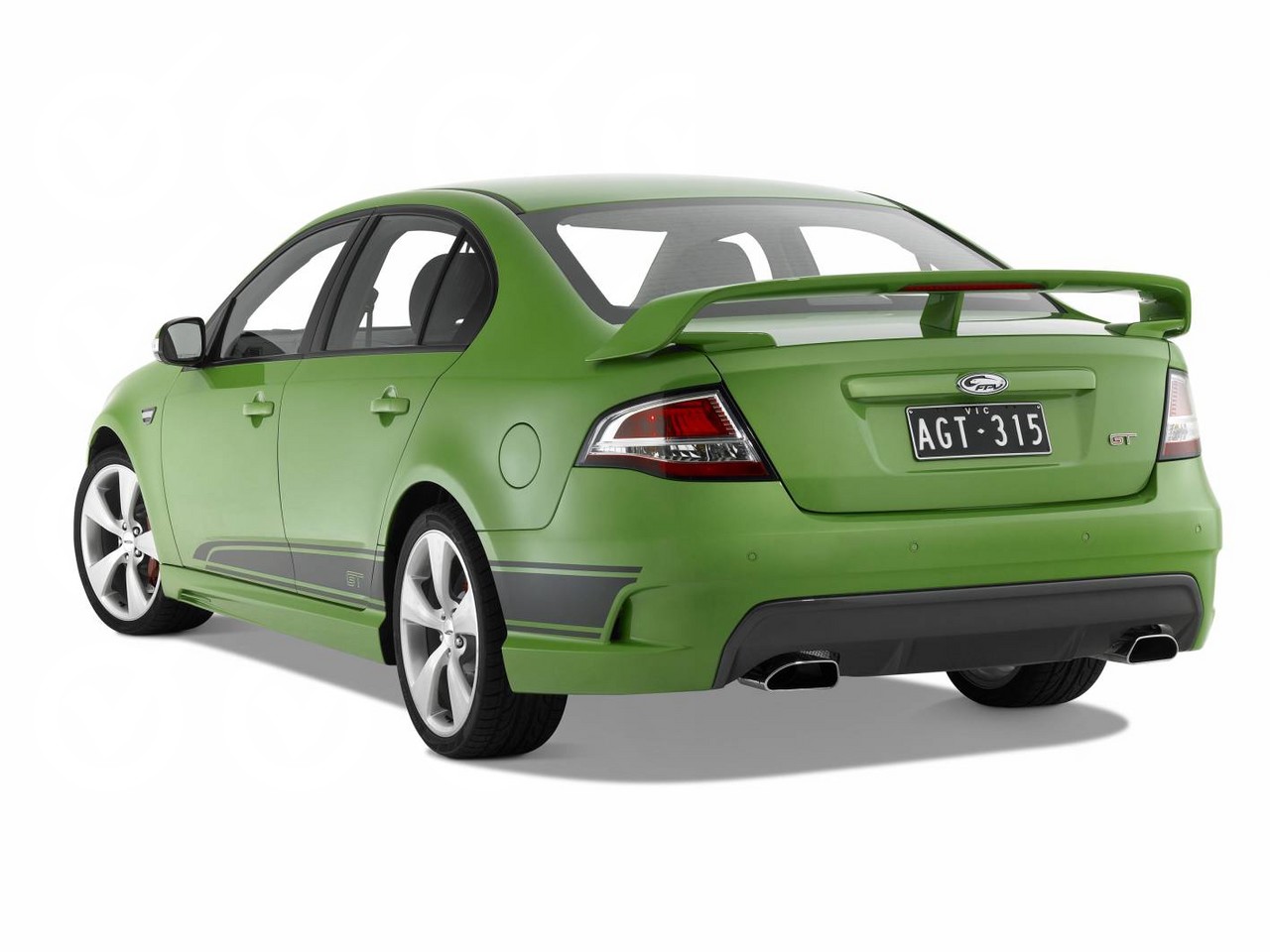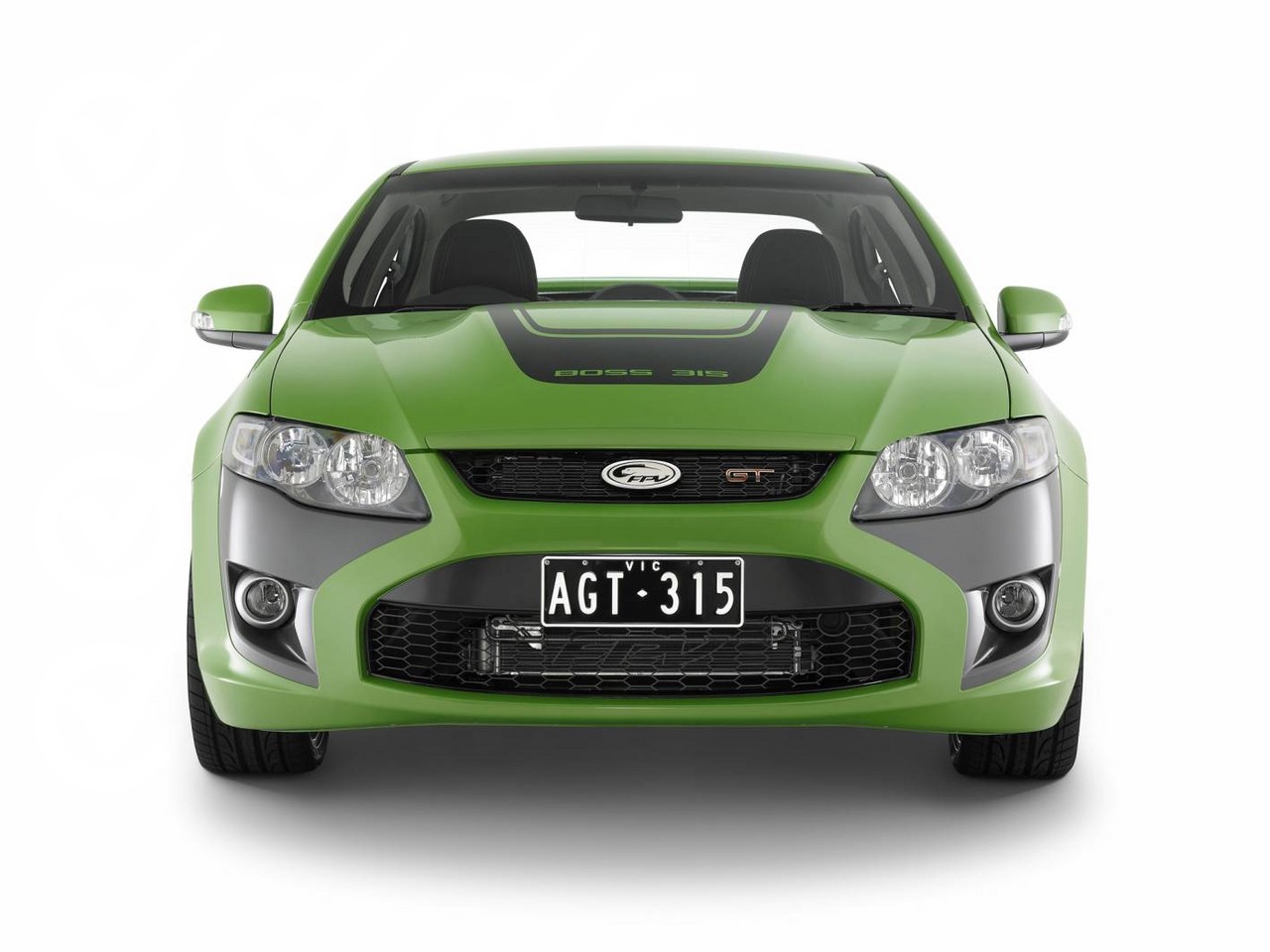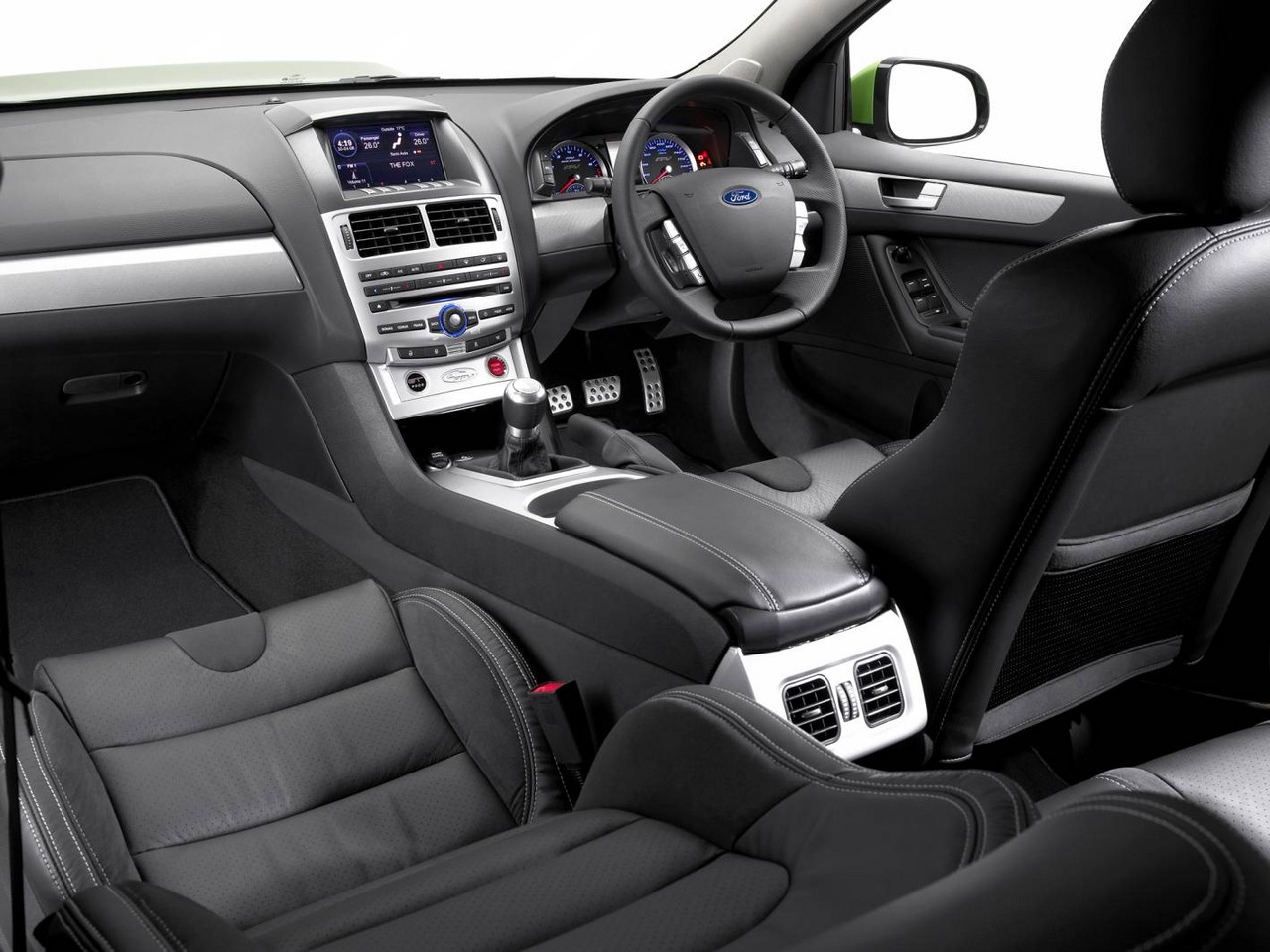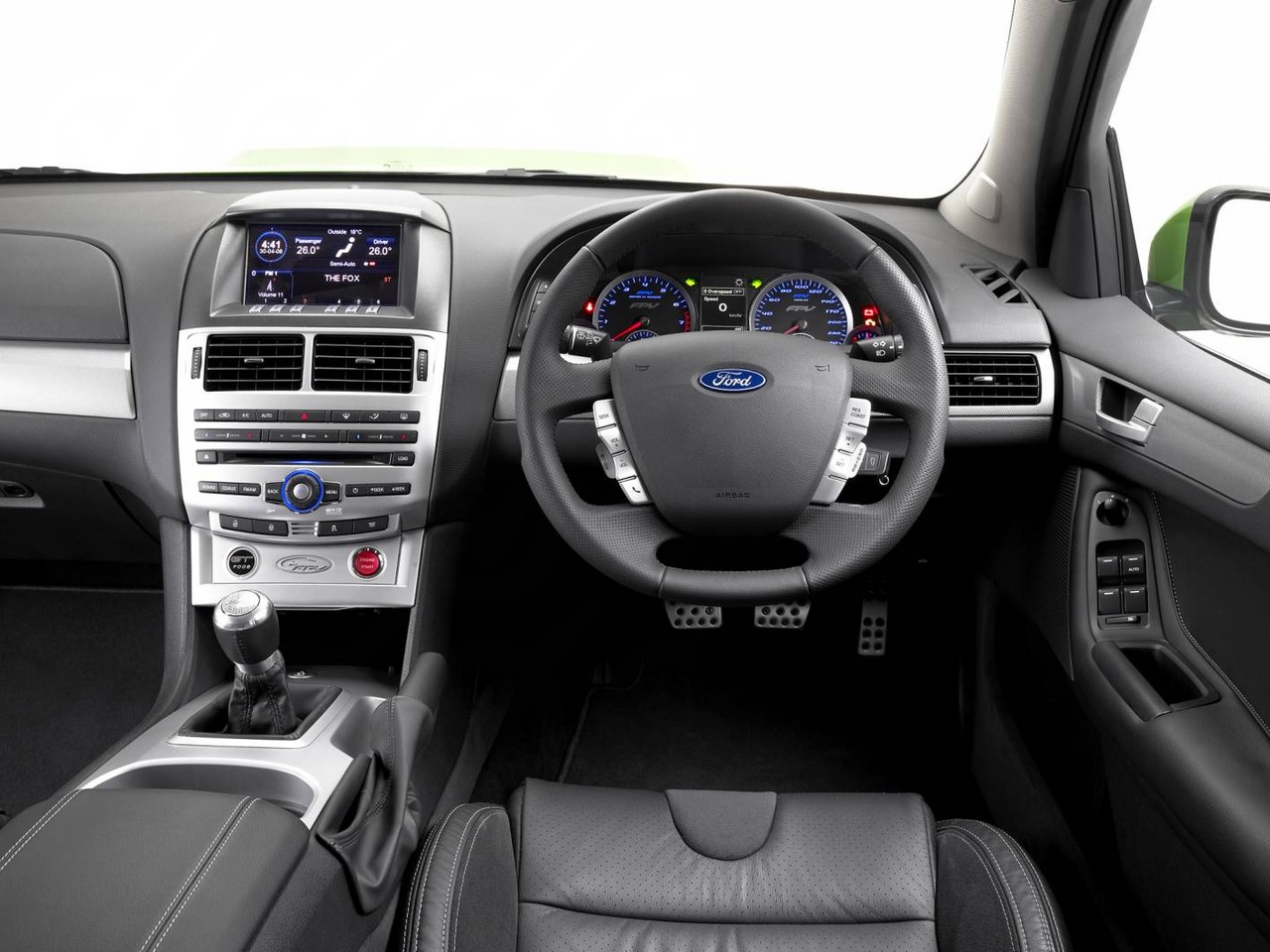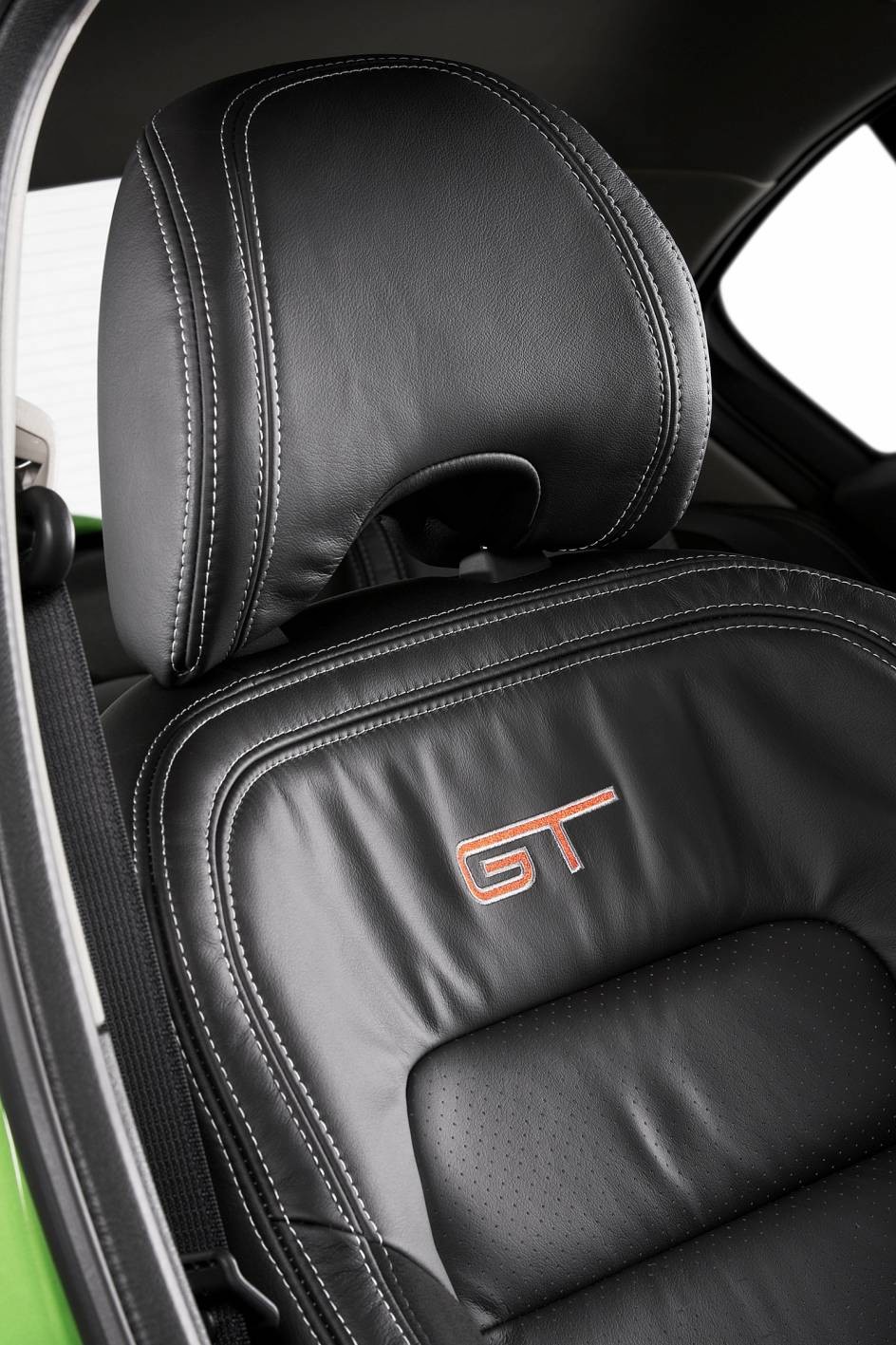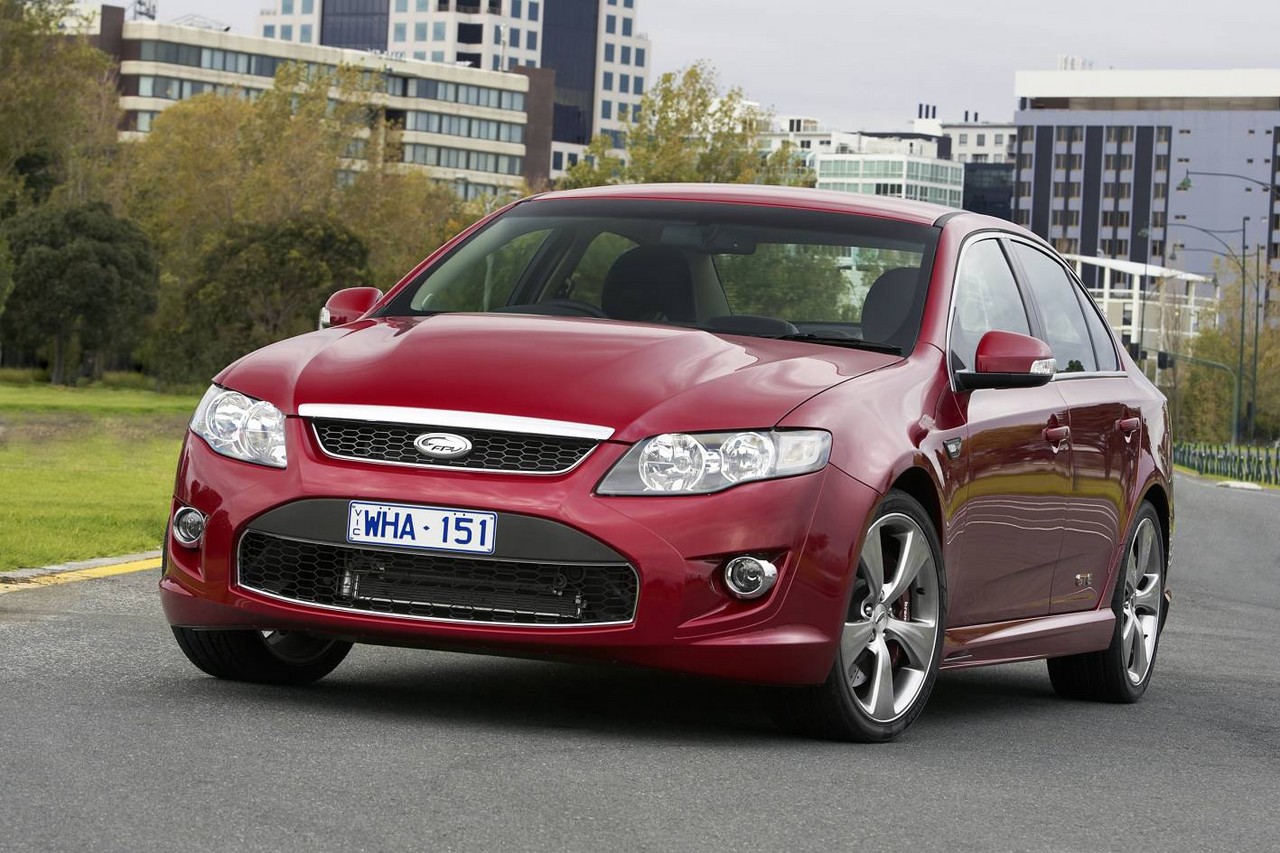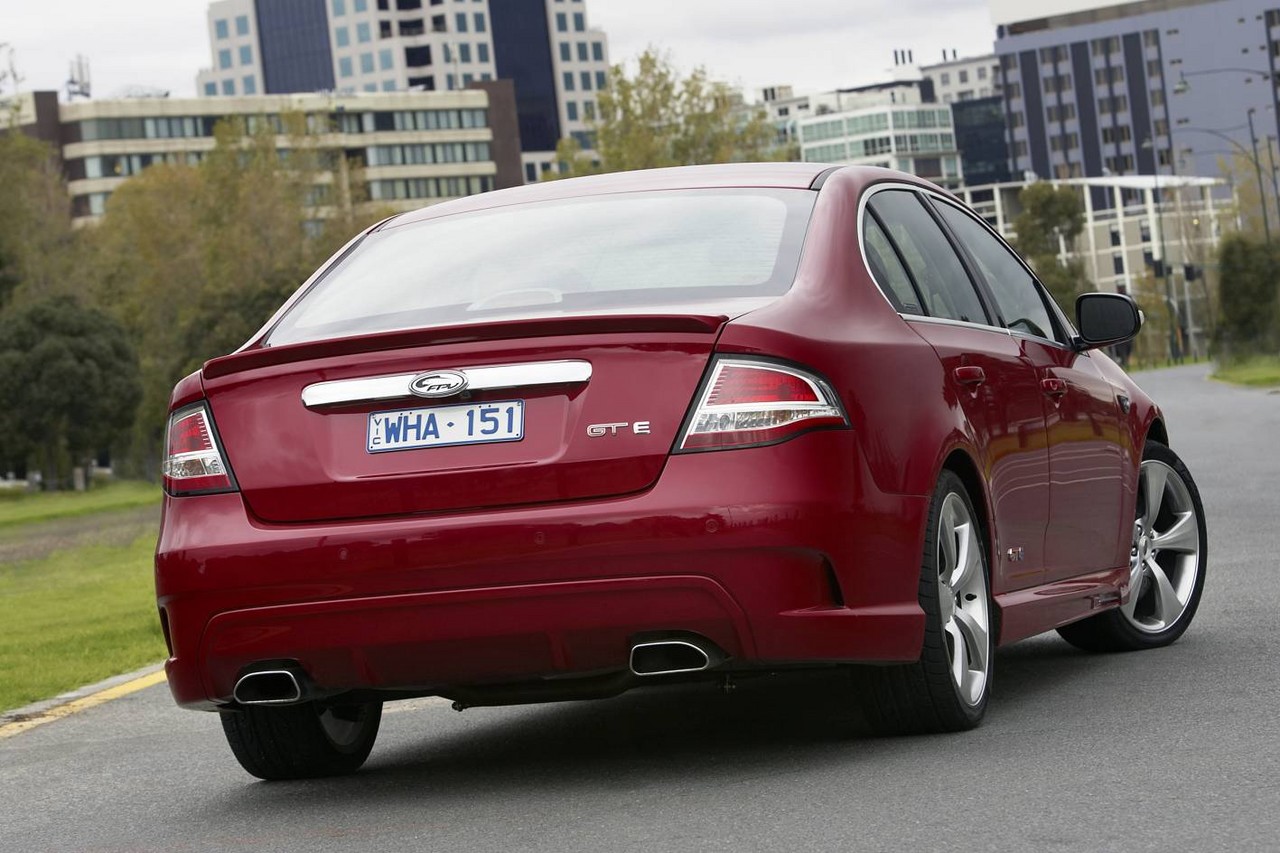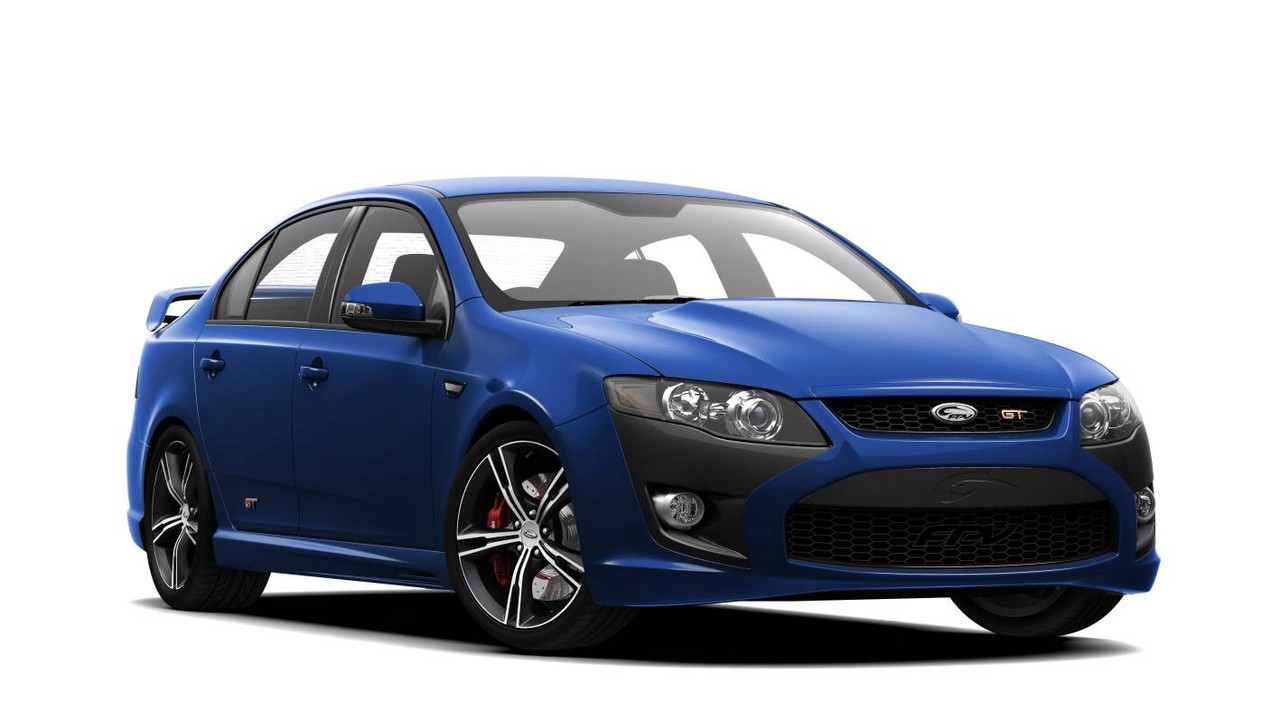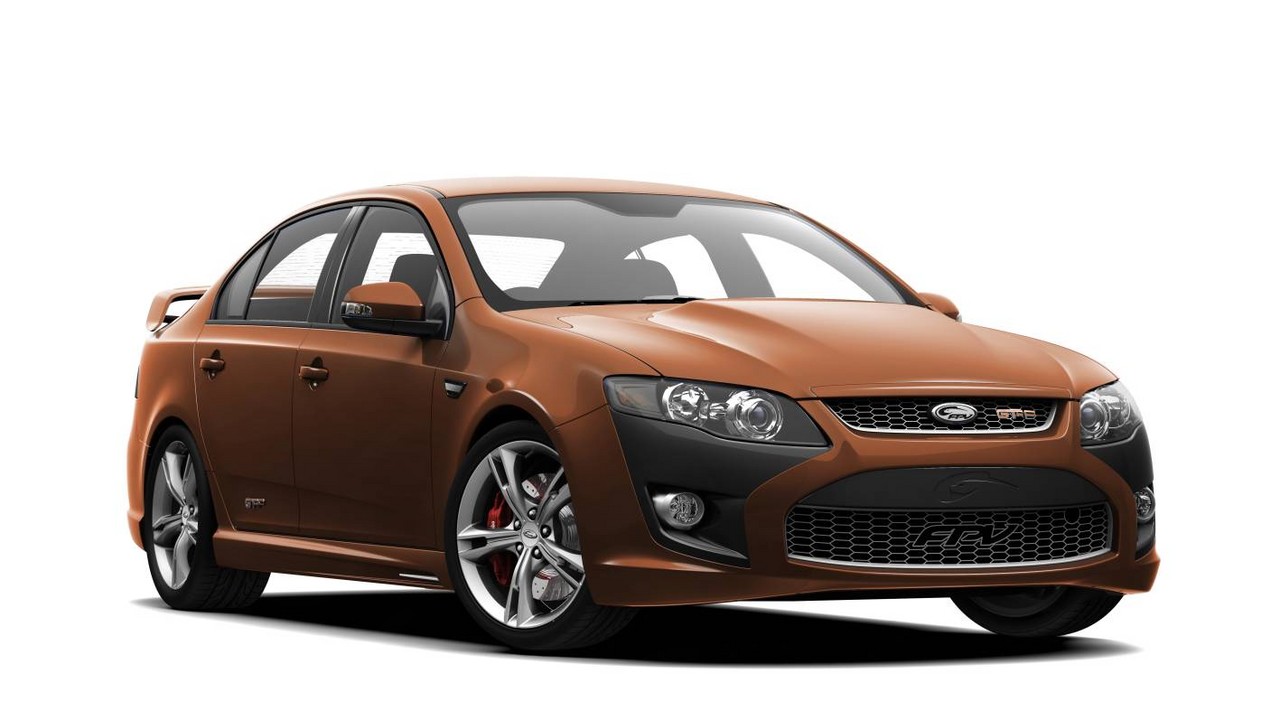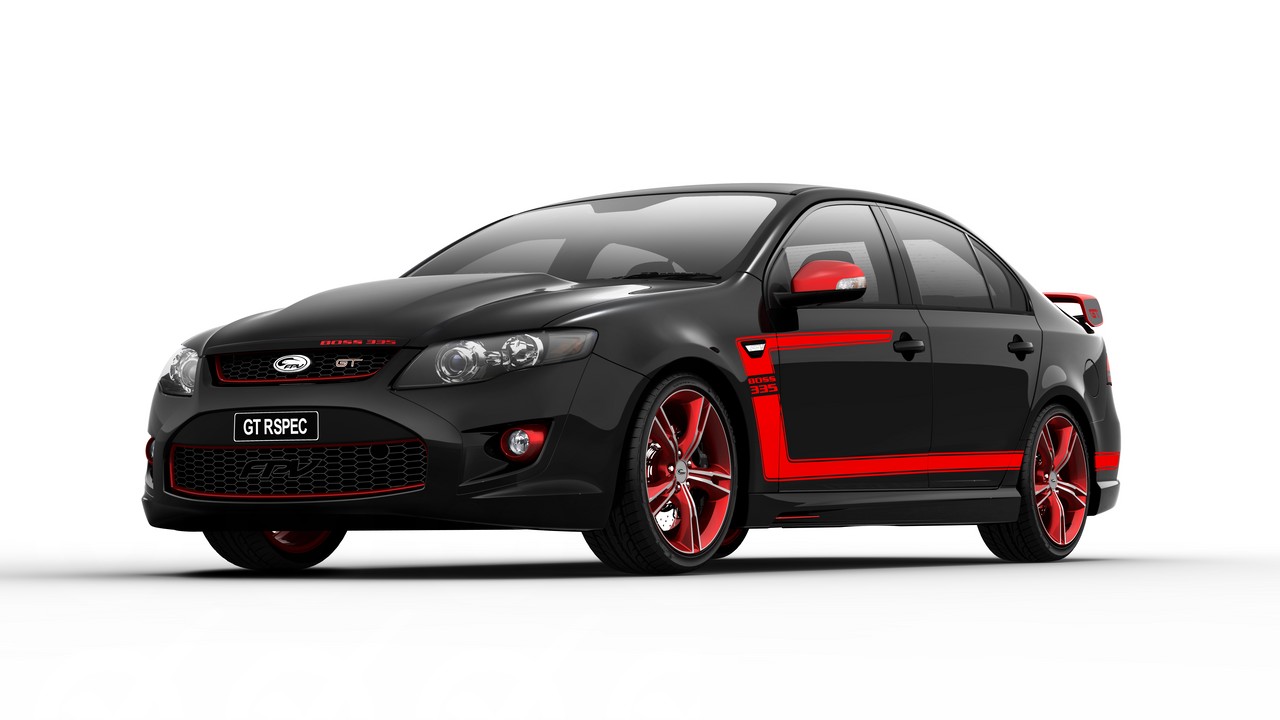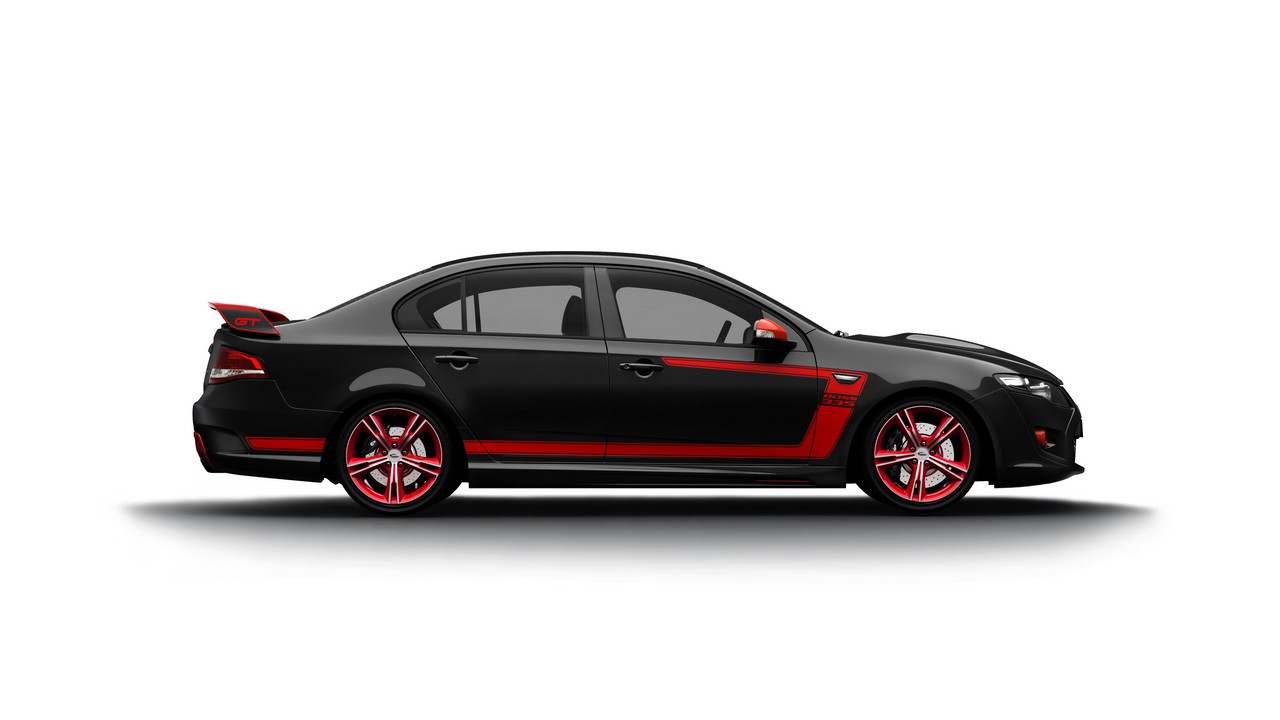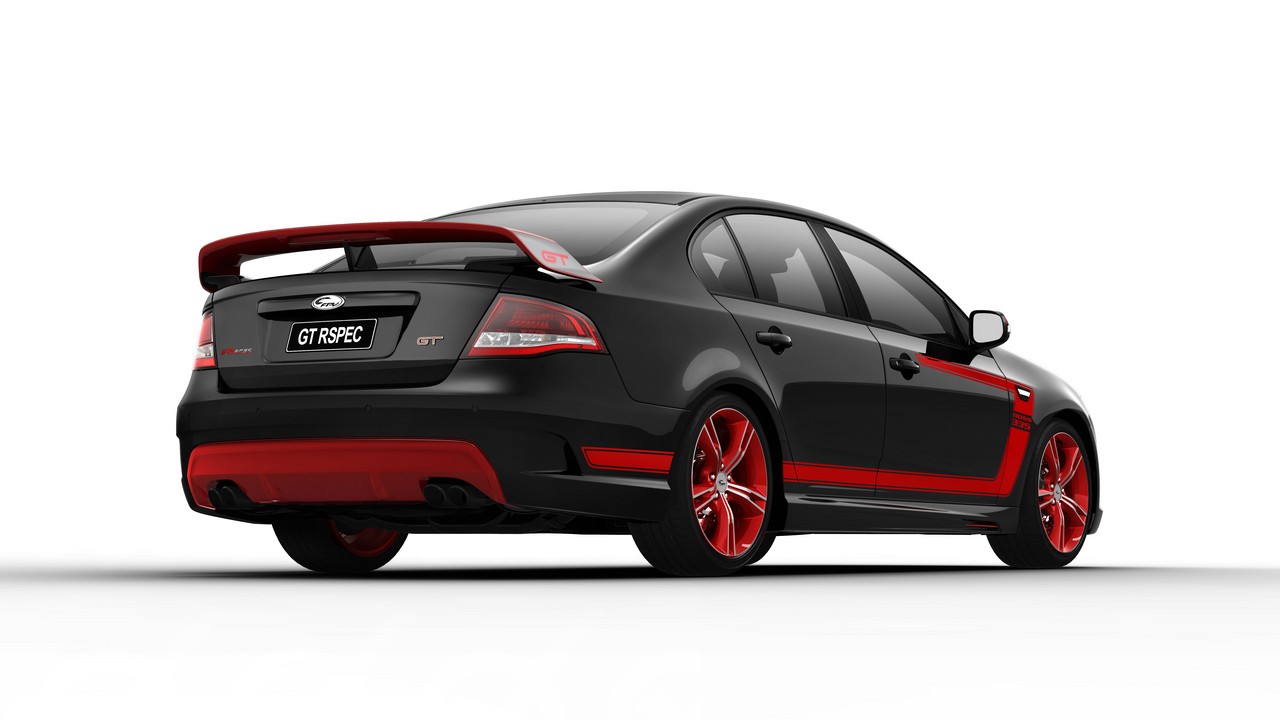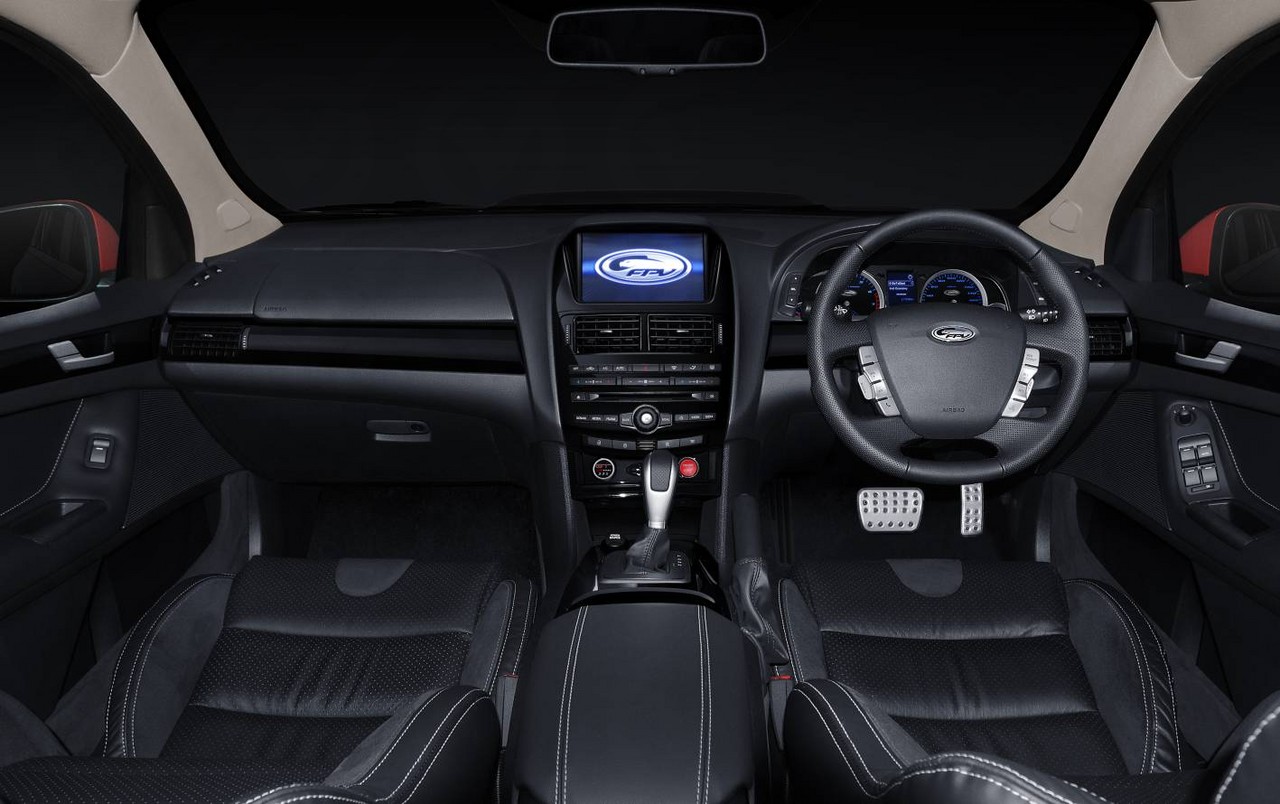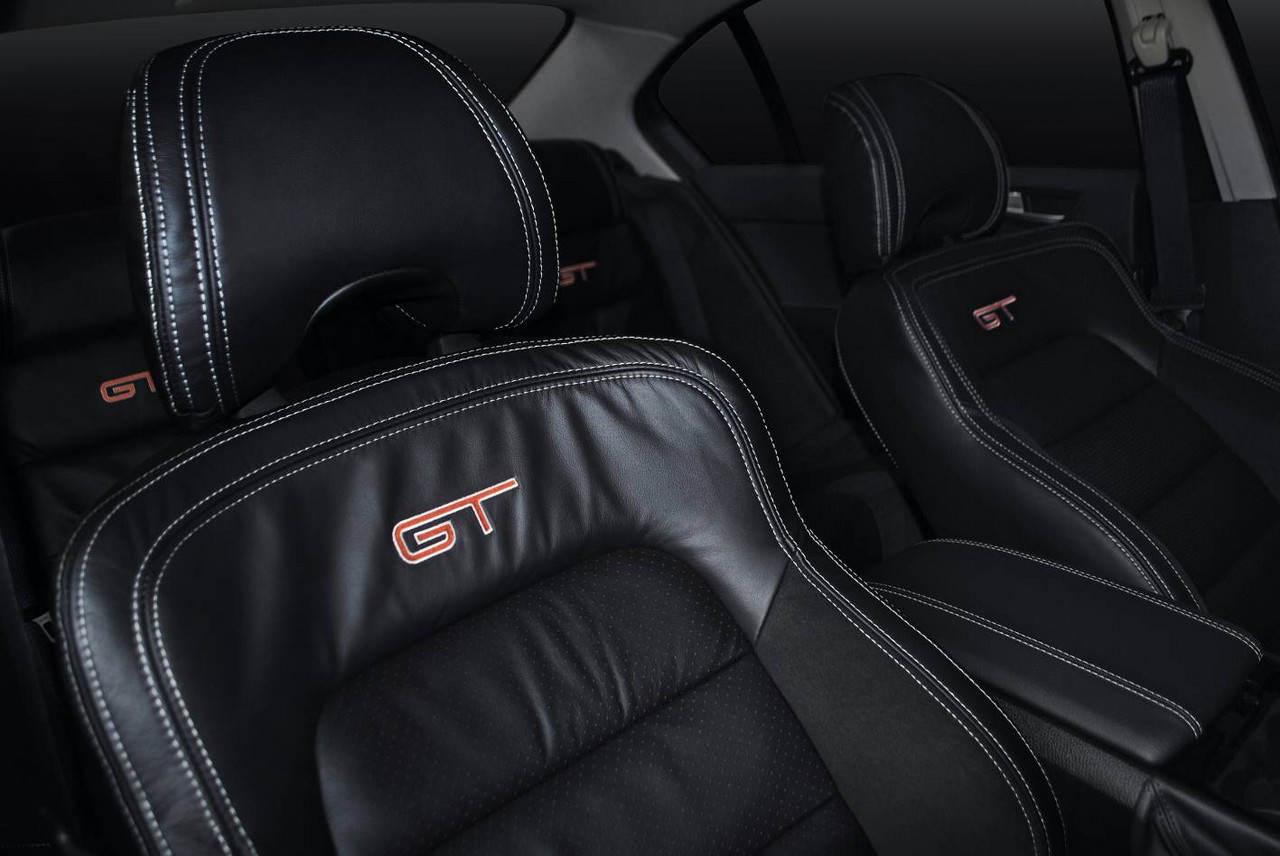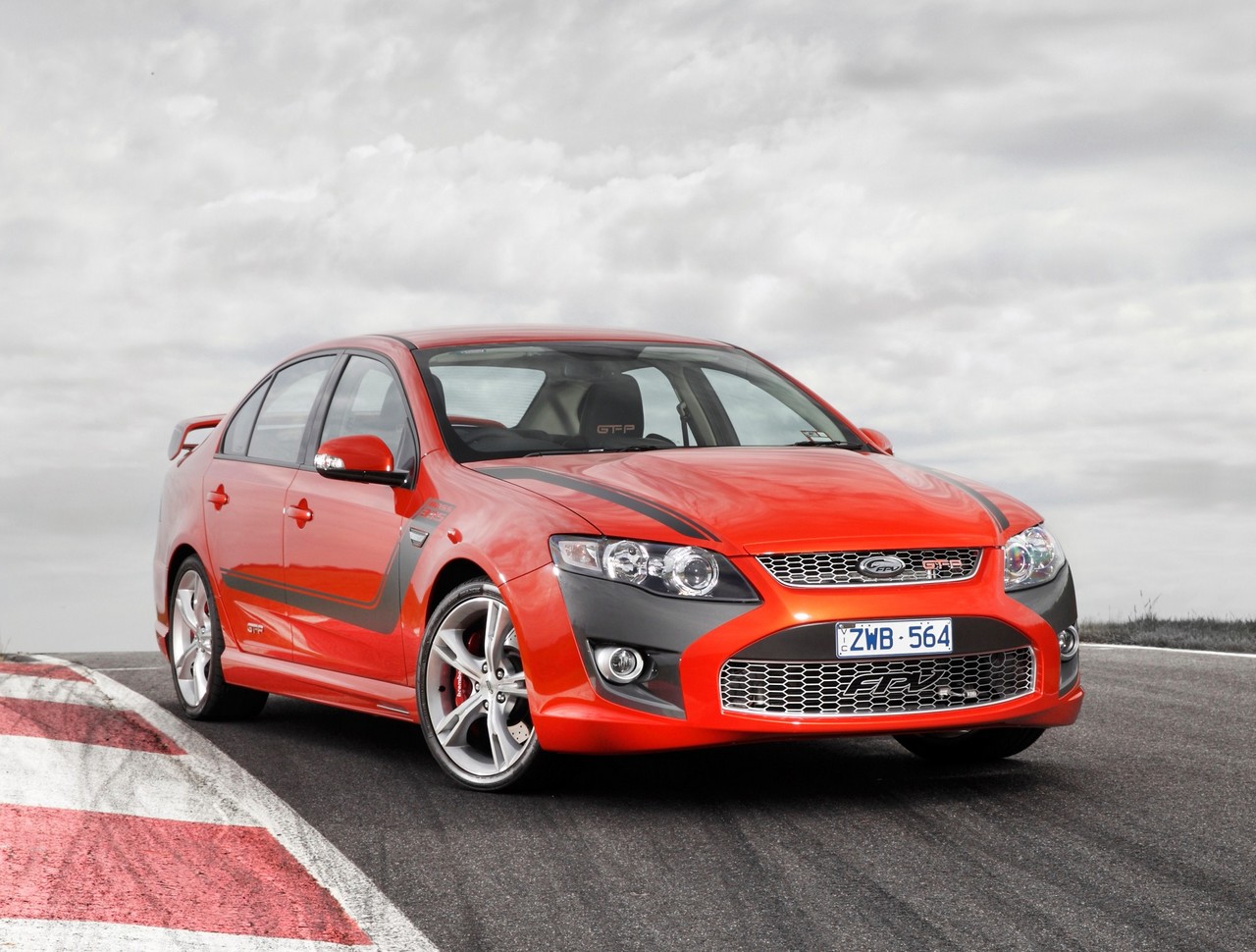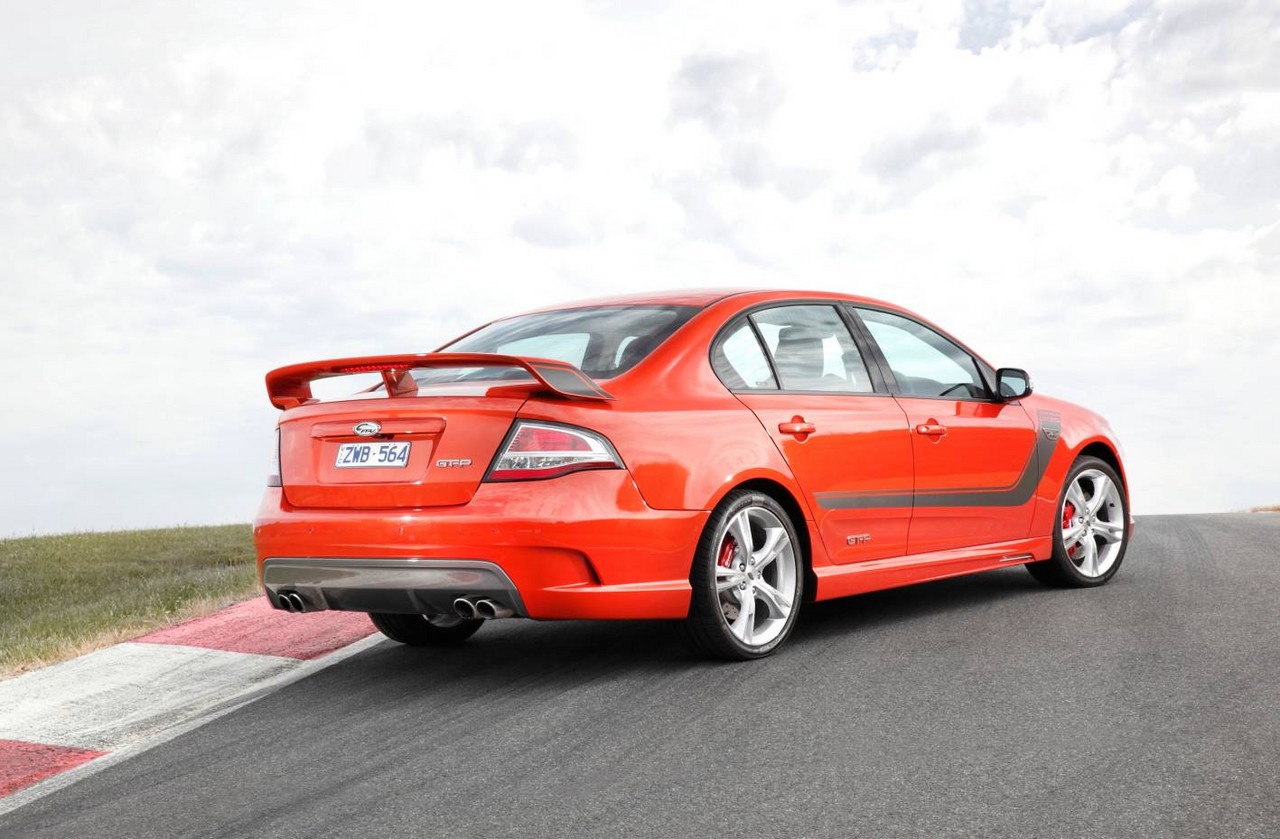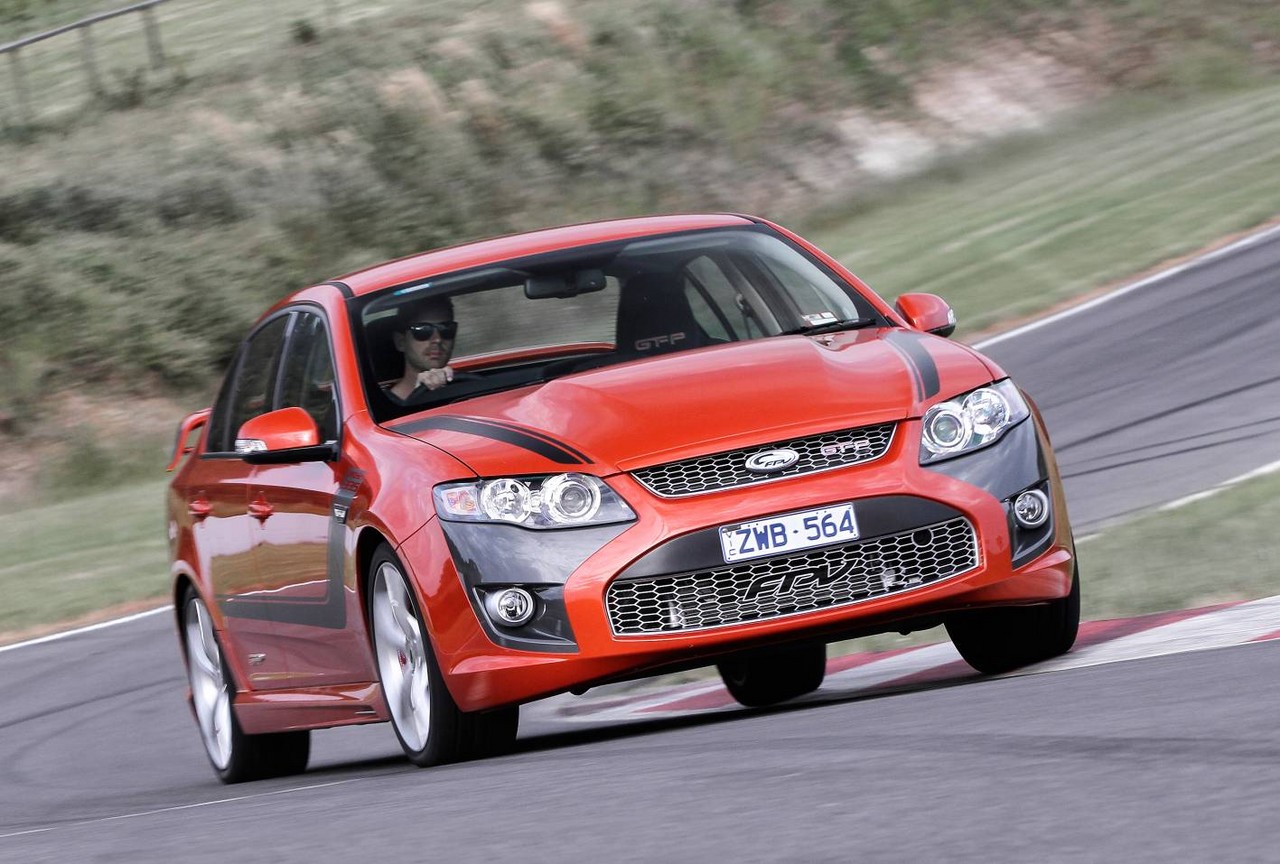
- Powerful ‘Boss 315’ and ‘Boss 335’ V8 engines
- Impressive dynamics
- Refined six-speed ZF automatic transmission
- Accurate, well-weighted steering
- Powerful Brembo brakes
- For ZF transmission, coolant lines in heat exchanger were susceptible to failure
- 5.4-litre V8 engine lacks low-rev response of HSV’s 6.0-litre V8
- Awkward driving position
- Suspension lacks low-speed compliance
- Prone to drivetrain clunks
- ‘Control Blade’ semi-trailing arm rear suspension inferior to VE Commodore-based four-link IRS
Review: FPV FG.I GT, GT-P and GT-E (2008-11)
Overview
Released in May 2008, the FPV FG Mk.I (FG.I) GT Series consisted of the GT, GT-E and GT-P models. Manufactured in Campbellfield, Victoria, the rear-wheel drive GT models were initially powered by 5.4-litre V8 petrol engines that were mated to either six-speed automatic or manual transmissions. In October 2010, however, the 5.4-litre V8 petrol engine was replaced with a 5.0-litre supercharged V8 unit due to the introduction of Euro IV emissions standards.
Boss 315 and Boss 335 V8 engines
Of the engines,
- the 5.4-litre Boss 315 V8 petrol engine had a cast iron block, cast aluminium cylinder head, forged steel crankshaft, cross-bolted main bearing caps, sintered connecting rods, double overhead camshafts (DOHC) per cylinder bank, roller finger followers, four valves per cylinder, twin knock sensors, coil on plug ignition and a compression ratio of 11.0:1. Compared to the Boss 302 engine, the Boss 315 engine had:
- New camshaft timing and profiles for higher lift and extended duration;
- Stronger pistons;
- An increased compression ratio (to 11.0:1, previously 10.5:1);
- A twin-plate throttle body to reduce pressure loss through the induction system;
- A new upper intake manifold plenum chamber for improved air flow;
- A new exhaust manifold;
- A new high flow, ‘straight-through’ twin exhaust system with new stainless steel exhaust manifolds;
- Higher peak engine speed of 6500 rpm (previously 6000 rpm);
- A new windage tray which reduced crankshaft windage losses; and,
- A new oil pan.
- Developed in Australia by Prodrive at a cost of $36 million, the 5.0-litre V8 ‘Boss 335’ Miami V8 engine was based on Ford’s naturally aspirated Coyote V8 engine that was introduced in the 2010 Ford Mustang GT. The hand-built ‘Boss 335’ Miami V8 engine had an aluminium block and cylinder head, an HTV 1900 supercharger (developed by Harrop Engineering and using Eaton Twin Vortices Series technology) providing maximum boost pressure of 0.4 bar (5.8 psi), a forged steel crankshaft, powder sintered forged connecting rods, double overhead camshafts, variable intake camshaft timing, roller finger followers, four valves per cylinder, and a compression ratio of 9.25:1. Due to its aluminium construction, the supercharged Boss 335 engine was 47kg lighter than the Boss 315 engine; the supercharged Boss 335 models were also fitted with a bi-modal exhaust system.
Transmissions
The FPV GT was available with six-speed Tremec TR6060 manual or six-speed ZF 6HP26 automatic transmissions.
Replacing the Tremec T56 manual transmission, the Tremec TR6060 had triple synchromesh on first and second gears and double synchromesh on all other gears (including revrese) which reduced gear shift efforts and shift travel. The reduced shift travel also provided increased space for the use of larger, stronger gears for greater durability.
The FPV GT was fitted with the high-performance ZF 6HP26 transmission which was rated for 600 Nm applications and had upgraded clutches with extra plates in the clutch packs. For the FG range, the 6HP26 transmission had a cylinder cut function whereby the fuel injectors would be deactivated during gearshifts to reduce shift times.
For the supercharged Boss 335 engine,
- The TR6060 transmission was fitted with a new bell-housing to suit a new twin-plate clutch system (shared with the Mustang GT500) and revised second gear synchros were implemented; and,
- The 6HP26 transmission was upgraded with a new 7-plate clutch pack and 4-planet planetary gearset for improved torque capacity.
Development
Developed in conjunction with the FG Falcon , the FPV GT Series had:
- A stronger body structure which made increased use of high-strength steels and ultra high-strength Boron steel and included a new front subframe, additional reinforcement inside the front rails, new high strength floor cross members, transmission tunnel reinforcement and a larger, stronger B-pillar;
- New Virtual Pivot Control Link front suspension (described below);
- A forward-mounted, Y-shaped steering rack with variable-ratio steering gear;
- Upgraded static sealing and triple-sealed doors;
- Redesigned fuel tanks; and,
- A self-adjusting park brake.
Dimensions
Compared to the FPV BF GT , the FG GT Series was 39 mm longer (at 4956 mm), 2 mm narrower (1868 mm), 22 mm taller (1466 mm) and had a 7 mm longer wheelbase (2836 mm).
Suspension
The FG GT’s double wishbone front suspension had two lower ball joints that connected the separate lower arms to the suspension knuckle. These two lower links created a virtual pivot of the lower arm – hence the ‘Virtual Pivot Control Link’ name – and allowed the suspension to behave as though the lower pivot point was at the intersection of the two arms. Due to the use of aluminium and high strength steels, the Virtual Pivot Control Link suspension was 22 kg lighter than that in the BF GT.
The independent rear suspension (IRS) had three control arms:
- A forged upper control arm;
- A stamped front lower control arm; and,
- A stamped rear lower control arm.
Each control arm had a cross axis ball joint on the wheel assembly end and was attached to the subframe and knuckle. Furthermore, the ‘Control Blade’ was a stamped trailing arm which provided lateral support and acted as a vertical pivot point.For the FG GT, the roll centre height was increased to reduce in-corner roll and improve straight line stability, while toe-angle was revised to improve steering feel and stability.
The FPV GT range had Sachs mono-shock dampers front and rear.
| Engine | Years | Models | Trans. | Peak power | Peak torque |
|---|---|---|---|---|---|
| 5.4-litre Boss 315 petrol V8 | 2008-10 | GT, GT-P |
6sp auto, 6sp man. |
315 kW at 6500 rpm | 551 Nm at 4750 rpm |
| GT-E | 6sp auto | ||||
| 5.0-litre super-charged Miami V8 petrol V8 | 2010-11 | GT, GT-P |
6sp auto, 6sp man. |
335 kW at 5750-6000 rpm | 570 Nm at 2200-5500 rpm |
| GT-E | 6sp auto |
Safety equipment
Standard safety equipment for the FPV FG GT Series included dual front airbags, front side airbags, full-length curtain airbags, ABS, electronic brake force distribution, brake assist, electronic stability control, traction control and front seatbelts with pretensioners and load limiters.
Brakes
The FPV FG GT had 355 mm by 32 mm cross-drilled and ventilated front brake discs with four-piston Brembo calipers and 328 mm by 26 mm cross-drilled and ventilated rear discs with single-piston calipers.
The GT-P and GT-E, however, had 355 mm by 32 mm cross-drilled and ventilated front brake discs with six-piston Brembo calipers and 330 mm by 28 mm rear discs with four-piston Brembo calipers.
Features
Standard features for the FPV FG GT included 19-inch alloy wheels with 245/35 ZR19 Dunlop Sport Maxx tyres, a seven speaker sound system with a six-disc CD player and auxiliary inputs (MP3/iPod), dual zone climate control air conditioning, a seven-inch colour display, four-way power adjustable driver’s seat, front seat adjustable lumbar support, cruise control, Bluetooth connectivity, front fog lamps, rear parking sensors, automatic headlights, remote central locking, tilt and reach adjustable steering wheel, multi-function leather-wrapped steering wheel, power windows and mirrors, 12 volt power outlets, a trip computer and an immobiliser.
As standard, the GT, GT-P and GT-E were fitted with a limited slip rear differential.
Compared to the GT, the GT-P added a six-way power adjustable driver’s seat, FPV floor mats and power adjustable front pedals (automatic models only). The GT-E was further distinguished by a rear vision camera, leather seats, driver’s seat memory settings and woodgrain interior trim.
2008 FPV GT 5th Anniversary edition
In October 2008, a limited run of FPV FG GT 5th Anniversary edition models were released; these models were distinguished by their 19-inch multi-spoke alloy wheels finished in Alpine Silver, six-piston Brembo brake package, ‘Nudo’ leather seats, embossed head restraints, ‘FPV 5thAnniversary’ decal and stripes.
2011 FPV GT Black
In August 2011, the FPV GT Black edition was released. Compared to the standard GT, the Black edition could be identified by its ‘Silhouette’ black paint finish, black alloy wheels, black fog lamp bezels, black exhaust outlets, black upper and lower grilles and matt black striping decals. Inside, there was a black finish for the Interior Command Centre, tissue box and door spears; standard features were also extended to include black leather seats and a reversing camera.
Related links
- Specifications: FPV FG.I GT and GT-P (May 2008)
- Specifications: FPV FG.I GT-E (May 2008)
- Brochure: FPV FG.I GT Series, Pursuit and Super Pursuit (January 2009)
- Brochure: FPV FG.I Range (October 2010)
Review: FPV FG.II GT, GT-P and GT-E (2011-14)
Overview
Released in December 2011, the FG Mk.II (FG.II) GT Series introduced subtle interior and exterior updates. Inside, there was a new Interior Command Centre (ICC) with an eight-inch colour touchscreen infotainment system and auxiliary USB input for the use of memory sticks, flash drives and external powered hard drives with memory support up to 1TB.
Visually, the FG.II GT range could be identified by its new lighting package with ‘precision design’ projector headlights and black bezels.
| Engine | Model | Trans. | Peak power | Peak torque |
|---|---|---|---|---|
| 5.0-litre s/charged Miami petrol V8 | GT, GT-P |
6sp auto, 6sp man. |
335 kW at 5750-6000 rpm | 570 Nm at 2200-5500 rpm |
| GT-E | 6sp auto | 335 kW at 5750-6000 rpm | 570 Nm at 2200-5500 rpm | |
| GT F | 6sp auto, 6sp man. |
351 kW at 6000 rpm | 570 Nm at 2500-5500 rpm |
Features
Compared to their FG.I predecessors, the FG.II GT and GT-P gained a reversing camera (previously limited to the GT-E). Beyond this, the GT-E and GT-P were fitted with satellite navigation and Traffic Message Channel (TMC). The satellite navigation system included evaluation for the most economical, shortest and quickest routes, 2D and 3D map modes, over-speed and speed camera warnings, places of interest, street house numbers, advanced lane guidance and signpost information and ‘junction view’ graphical representations of the road.
2012 FPV GT R-Spec
In August 2012, the limited edition GT R-Spec was released. Compared to the standard GT, the R-Spec edition was fitted with nine-inch wide rear wheels with 275/35 Dunlop Sports Maxx tyres, a launch control function (for both automatic and manual transmissions) and stiffer engine and transmission mounts for reduced driveline vibration. Furthermore, the front suspension was fitted with stiffer upper control arm bushes, stiffer upper suspension strut mounts and re-tuned dampers, while the rear suspension had higher spring rates, re-tuned dampers, larger anti-roll bars, reinforced lower control arms and revised toe settings. Visually, the R-Spec could be identified by its unique stripe package and paint treatment. Inside, R-Spec featured ‘Shadow’ leather sports seats with GT logo embroidery and piano black interior finishes.
2014 FPV GT F
The FPV GT F was released in June 2014 with production limited to 550 units (500 for Australia and 50 for New Zealand). Compared to the standard GT engine, changes to boost control within the engine management system (or Powertrain Control Module, PCM) resulted in a peak power output of 351 kW. However, ‘transient overboost function’ could provide peak power in the range of 410-420 kW and peak torque of up to 650 Nm depending on the prevailing atmospheric conditions. In higher ambient temperatures, the overboost function would be limited to fifteen (15) to twenty (20) second bursts.
The GT F had the same suspension and tyre package as the GT R-Spec, while a Brembo braking package (with six-piston front and four-piston rear calipers) was fitted as standard. Changes, however, included a new calibration for the six-speed ZF automatic transmission and upgraded software for the Bosch traction control system.
Visual cues for the GT F included a ‘stealth’ stripe design package which, according to Ford, was ‘evocative of the blacked-out headlights from Ford muscle cars of the 70s’. Available in Winter White, Kinetic (blue), Silhouette (black), Octane (orange) and Smoke (dark grey) paint finishes, the GT F featured standard matte black stripes for all colours, with a ‘performance white’ option for the Kinetic finish and metallic gold for Silhouette; silver strip options were also available for the Smoke and Silhouette finishes.
According to Ford, the GT F interior featured richer, darker tones and more lustrous finishes. Although the audio system and centre console was shared with the GT E, the GT F’s featured a new G-Force meter, gear knob cover, dash spear and GT F-branded build number.
Brochures
- Brochure: FPV FG.II Range (January 2012)
- Brochure: FPV FG.II GT R-Spec and Pursuit Limited Edition (August 2012)
- Brochure: FPV FG.II Range (May 2013)
Related links
